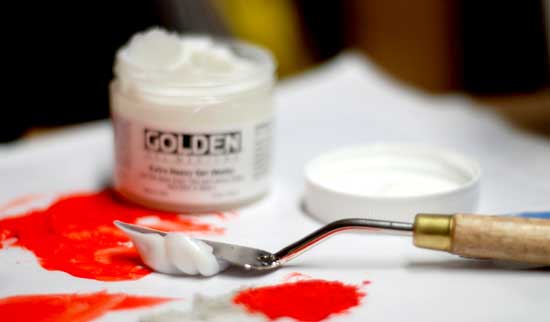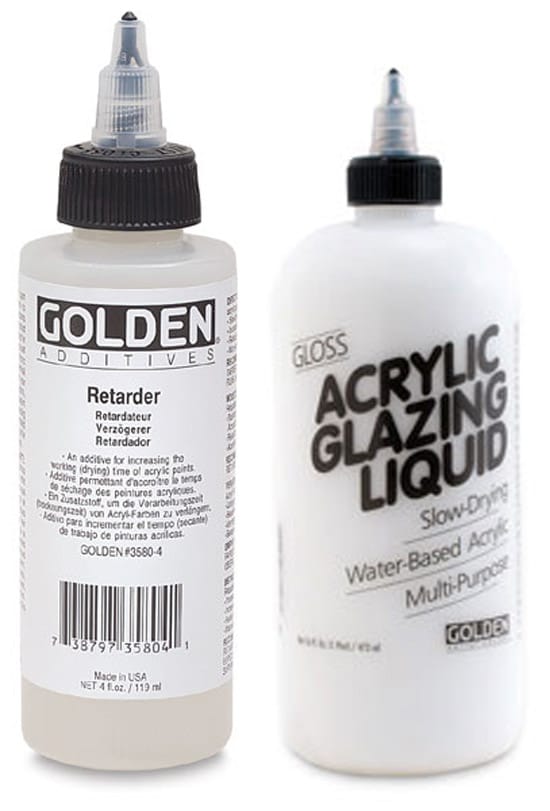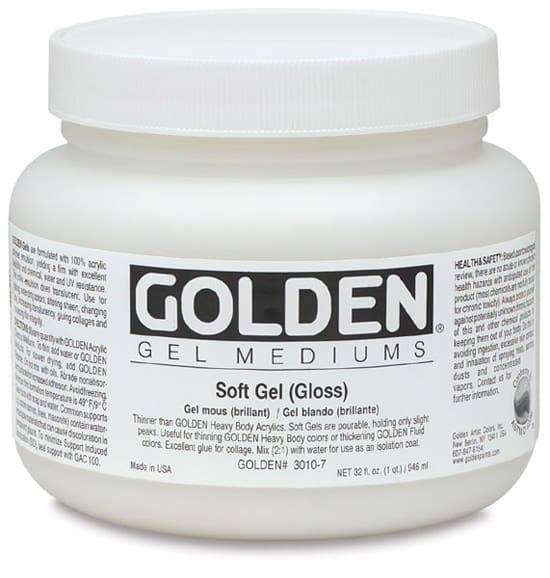How To Use Golden Clear Tar Gel

Do you feel you should be using mediums?
You've probably brought a couple and had a play around, but are you using the right ones?
Or is the overuse of mediums doing more harm than good?
Acrylic mediums can change the consistency of acrylic paint and allow you more flexibility and creative freedom than any other type of paint.
The trick is to use the right ones for the right situation.
What is the difference between gels & mediums?
Gels are usually used thickly, to keep shapes and add texture.
Mediums are pourable and used to thin out paints and give the Acrylics extra working time for blending…
Part 1 Acrylic Gels:
How to read an acrylic gel label
The name is often descriptive of the consistency, binder and lustre finish.
For example:
- Soft Gel Gloss – Soft (thinner consistency) gel (binder) gloss (lustre)
- Regular Gel Matte – Regular (same consistency as regular paint) gel (binder) matte (lustre)
- Heavy Gel Semi-Gloss – Heavy body (thicker consistency) gel (binder) satin (lustre)
So if you are using a heavy body acrylic and want to make it go further but don't want to change its consistency, then you can add 'Regular Gel' (either in matte, semi-gloss or gloss)
This will increase the volume of your paint without having to use loads of pure pigment. (It will, of course, dilute the coverage quality of the paint)
The name doesn't mean that a soft gel will have a soft finish when it has dried. It just means it has a softer consistency, i.e: thinner consistency, it is a bit misleading.
If you think of them in cooking terms mediums are like pouring cream, gels can range from double cream to clotted cream!
In the video tutorial above I demonstrate Regular Gel and Extra Heavy Gel
The 7 main properties of gels and mediums
Consistency: Gels range from soft to extra heavy depending on the finish you are after.
Lustre: Usually you will have a matte, semi-gloss and gloss finish.
Transparency: Glazing liquid can create thin, translucent paint films – ideal for classical painting techniques such as glazing.
Glueing/Laminating: Soft Gel Gloss can be used as a glue substitute for collage effects.
Paint film: Creating a layer of paint than 'holds together', if too watery an acrylic paint film can often not hold in a thin layer it can separate out. Using a medium, such as a glazing medium, you can work with thin layers that don't run but still have a glass-like finish.
Cost: By using a medium to extend the paint you can make the paints go further.
Adding Texture: Instead of using thick paint, you can create texture with gel and paint on top.
Why are there so many?
Good question, some manufacturers have a huge selection of mediums which can often be overwhelming to choose from, so often you just plum for one, a random choice on instinct and this doesn't achieve the results you want, so you don't try any at all.
I use 2.
I'm very keen on trying to keep your painting as simple as possible when you first start because the less you have to worry about technically, the more time you can actually get painting.
I use Soft Gel Gloss & Glazing Liquid Gloss on 90% of my acrylic paintings.
That's it.
Why?
The Soft Gel Gloss has 2 distinct uses:
1. To dilute the paint consistency yet still keep visible brush marks.
2. Diluted with water to create an isolation coat. An isolation coat helps to separate your painting from a final varnish layer and protect your painting from the atmosphere. (see How to apply an isolation coat)
The Glazing Liquid Gloss is used to help blend edges and achieve very thin glazes when working at an easel.
Pro tip: I use the gloss version of the glazing liquid because on semi-gloss and matte versions, the matting agent contained within the medium can sometimes cause a milky finish, especially on very dark, black areas of a painting.
What Are Gels Made Of?
Gels are made from the binder that is used in the creation of acrylic paints – an acrylic polymer.
So, for example, yellow ochre acrylic paint contains: pigment (yellow ochre) & binder (acrylic polymer)
A gel contains: binder (acrylic polymer) so is essentially a colourless paint.
They come in a variety of textures and consistencies that can be combined with your paint to manipulate the effects you are after.
It's all about the money
One of the primary roles of gels and mediums is to extend the paint for economical reasons.
By using artist quality acrylics mixed with a gel (Regular gel or Soft gel would work best), you can effectively create your own 'home-made' student range.
A note of caution: although the consistency would be similar to the artist range, the way the paint behaves and feels on the brush is slightly different so I tend to use it like this only for my under-painting.
When mixing the paint with gels, there are no limitations to the amount of gel you can add, all that will happen is the paint mixture will become less and less opaque. This would be the same if you diluted the paint with water of course, but with water, it would make the consistency thinner whereas with the gel you can maintain the heavy body of the paint.
I prefer to slightly dilute my paints when I'm blocking in local colours to a painting, so I would use Soft gel gloss for this.
This thins the paint consistency from the tube (using GOLDEN heavy body acrylics) yet creates the perfect consistency for my initial 'lay in' stage of the painting.
It's like being your very own mini paint manufacturer!
Pro tip: Archivally the acrylic mediums are very safe, with no discolouration as opposed to oil paint where the more oil added, the slower the drying time and higher the likelihood of the painting to discolour over time – due to the extra quantity of oil in the paint film.
In the video tutorial above I demonstrate Soft Gel Gloss and Coarse Pumice Gel
Are you a painter or a pourer?
Different gels have different chemical makeups which affect the way they mix with your paint. If you want the paint to still feel like paint, retain brushstrokes, stay in peaks or texture then a gel with what is technically called short rheology would be perfect. The 'rheology thickener' helps the medium to stay in a fixed shape rather than level out.
So if you want to create a palette knife textural feel to a piece, using an 'Extra Heavy Body Gel' would create stiff peaks that hold in a shape.
Other gels have been specifically designed to level out and will never be able to stay in a fixed shape. Clear Tar Gel, as the name suggests, has a very stringy, gloopy texture much like treacle. (sorry about another baking analogy) this is called long rheology .
So even though 2 gels could have the same thickness and consistency (often referred to as viscosity) they would behave very differently depending on if a 'rheology thickener' had been added.
For example:
Self-Levelling Clear Gel and Soft Gel are the same consistency, the Self Leveling Gel will be great for creating a painting where you don't want to see any visible brush-marks whereas the Soft Gel will help to achieve a more textural effect.
Please note: Clear Tar Gel and Self Leveling Gel are the exceptions to the Gel rule of adding texture and viscosity to your acrylic paint.
Specialized Gels
Golden produce several specialist Acrylic Gels that add rough or granular texture varying from Pumice Gel that can be great for beach scenes to moulding paste that is brilliant for building surfaces up, it can even be carved into!
Liquid Mediums, such as Acrylic Glazing liquid gloss are great for increasing the working time of Acrylics and make blending that little bit easier.


Video demonstrating Acrylic Glazing Medium & Acrylic Retarder
Want to learn more about how to use gels in your acrylic paintings?
You should have a look at my Absolute Beginners Acrylic Painting Course, teaching you classical painting techniques with the modern medium of acrylics.
How To Use Golden Clear Tar Gel
Source: https://willkempartschool.com/how-to-use-acrylic-mediums-without-ruining-your-paintings/
Posted by: lawsonsages1952.blogspot.com

0 Response to "How To Use Golden Clear Tar Gel"
Post a Comment